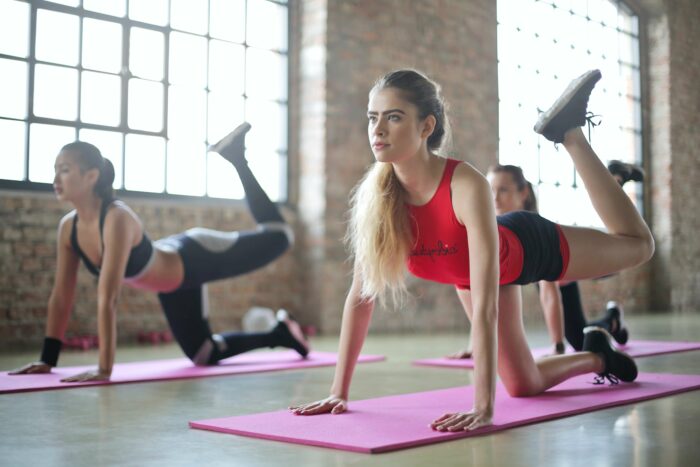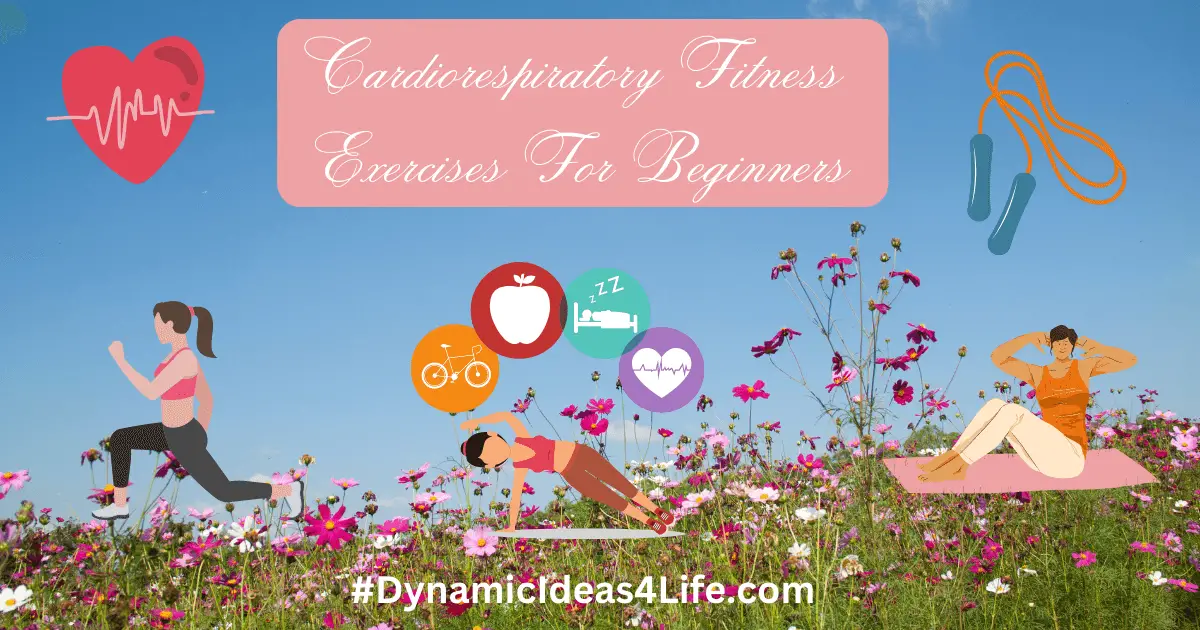When it comes to overall health and fitness, few things are as important as cardiorespiratory fitness. It not only strengthens your heart and lungs but also improves your endurance, boosts energy levels, and promotes overall well-being.
Cardiorespiratory Fitness For Beginners is an exciting opportunity to embark on a transformative journey towards a healthier and stronger you. By focusing on cardio exercises that are easy to learn right from the start you can build a solid foundation for your fitness routine.
With each workout, your heart and lungs will grow stronger, paving the way for improved endurance and increased energy levels. So whether you choose brisk walking, jogging, cycling, or dancing, these exercises will not only benefit your physical well-being but also contribute to stress reduction and overall mental clarity.
If you are a beginner to cardio exercises here is how you can discover the benefits and essential tips to introduce Cardiorespiratory Fitness into your daily workout sessions.
Now, let’s get started…
Cardiorespiratory Fitness For Beginners
For anyone looking to begin a new exercise and fitness regime Cardiorespiratory fitness (or Cardio for short) is definitely something to try. In fact, for anyone that works out or even for those who don’t doctors recommend 30 minutes of Cardiorespiratory Exercise every day. [R]
Those who don’t do Cardio really should and this is especially true if you lift weights. But even if you don’t the health benefits of Cardiorespiratory Exercise and Fitness are very clear to see and a great thing to start doing.

Understanding Cardiorespiratory Fitness
Cardiorespiratory Fitness refers to the ability of your heart, lungs, and blood vessels to deliver oxygen to working muscles during physical activity. It is an essential component of overall fitness and plays a vital role in maintaining good health.
Improved cardiorespiratory health can help enhance mental clarity, lower the risk of chronic diseases, and increase longevity. Engaging in these activities not only benefits physical health but also has a positive impact on your overall well-being.
By improving the efficiency of your heart, lungs, and circulatory system, cardiorespiratory fitness enhances the delivery of oxygen and nutrients to your muscles, enabling them to perform better during physical exertion.
Regular cardio exercise has been linked to a lower risk of conditions such as heart disease, high blood pressure, stroke, type 2 diabetes, and certain types of cancer.
By strengthening your cardiovascular system, cardiorespiratory fitness helps maintain healthy blood pressure levels, improves cholesterol profiles, and enhances blood sugar regulation.
The Main Benefits of Cardiorespiratory Fitness

By regularly taking time out of your day to practice Cardiorespiratory fitness there are a number of health benefits that you might discover. These include all of the following;
- Fat Burning: Engaging in regular cardio exercises helps burn calories and is great for shedding excess weight, leading to healthier body composition. This a very good reason to start cardio and for a lot of different people.
- Increased Endurance: Regular cardio workouts gradually improve your stamina and endurance levels, allowing you to engage in exercise and fitness activities for longer periods of time and will less fatigue.
- Stronger Heart and Lungs: Cardiorespiratory exercises strengthen your heart muscle and improve lung capacity, enhancing their efficiency and overall cardiovascular function.
- Stress Reduction: Cardio workouts stimulate the release of endorphins, the body’s natural feel-good hormones, which can alleviate stress and boost mood.
- Enhanced Overall Well-being: Improved cardio fitness can result in better sleep patterns, increased energy levels, and a heightened sense of overall well-being.
Also, Cardio workouts have also been shown to improve cognitive function, including memory, attention, and decision-making abilities. They have also been found to help improve mental health by reducing feelings of stress and anxiety.
Essential Cardiorespiratory Fitness for Beginners
Cardiorespiratory Fitness for Beginners can be achieved through a variety of exercises that are easy to incorporate into your daily routine. Brisk walking for example is a low-impact activity that can be done at a faster pace to elevate your heart rate. For those who don’t like intense workouts like jogging or running is an excellent choice to burn calories and improve cardiovascular health.
Cycling, on the other hand, whether on a stationary bike or outdoors, provides a low-impact option that is gentle on the joints while delivering a great cardiovascular workout.
Also, Skipping (Jumping Rope) is a simple yet effective exercise that can be done anywhere, and as your fitness improves, you can gradually increase the duration.
Lastly, engaging in Aerobic Exercises such as Zumba or other types of dance classes not only raises your heart rate but also adds an element of fun to your fitness routine.
By incorporating these exercises into your cardiorespiratory fitness journey, you’ll build endurance, improve heart and lung function, and enjoy the benefits of an active and healthy lifestyle.
Tips for Getting Started
For anyone interested in introducing Cardiorespiratory Fitness into their daily routine there are a few tips that are good to know. Basically, nothing major but just a few ideas to think about. I will share these below.
- Consult with a Healthcare Professional: If you have any underlying health conditions or concerns, it’s advisable to consult a healthcare professional before beginning any new exercise program.
- Start Slow and Gradually Increase Intensity: Begin with shorter exercise sessions and lower intensity levels, allowing your body to adapt and avoid overexertion. You can always do more later but ease yourself in gently.
- Set Realistic Goals: Establish achievable short-term and long-term goals to stay motivated and track your progress.
- Make it a Daily Habit: Consistency is key to reaping the benefits of cardiorespiratory fitness. Aim for at least 150 minutes of moderate-intensity aerobic activity per week and spread it out over several days.
- Mix it Up: Variety in your workouts not only prevents boredom but also engages different muscle groups and challenges your body in new ways. Keep an open mind and explore different ideas to try out.
Now, if you have read this far then I’m sure you probably have quite a good idea what cardio is all about. The concept is largely the same. To get your blood pumping, to exercise both your heart and lungs.
Below I will share some ideas;
Basic Cardiorespiratory Exercises
1 Hour Cardio Workout
*Note this workout plan was originally published at PureGym.com. This is an easy 6-step routine;
- Warm up with a light jog or brisk walk for 10 minutes.
- Work: run for one minute, giving it an 8 out of 10 effort.
- Recover: walk or jog for two minutes.
- Repeat 10 times.
- Cool down with a light jog or brisk walk for 5 minutes.
- Stretch to cool down.
This will probably take a bit of getting used to but with a few sessions, this should get easier. Although if you do want to try something out I will include a few more ideas to try below.
15 Minutes of Jump rope (Skipping)
Skipping is an excellent example of an effective cardiorespiratory exercise. Jumping rope strengthens calf muscles and improves the elasticity of surrounding tendons and connective tissue.
It also helps build the arm muscles, as well as the abdomen. To try this as part of your exercise routine follow these steps below;
- Lightly grip the handles of the skipping rope.
- Relax your shoulders and keep your elbows close to the torso.
- Gently bend your knees.
- Rotate the rope from the wrist and keep a smooth arc.
- Jump low to reduce the impact on the knees and ankles.
For many that train jump rope is a very popular cardiorespiratory exercise. It can be a difficult exercise, to begin with, but it is a great way to oxygenate and circulate your blood supply. Jump rope is often practiced by boxers for this reason but it is not for everyone.
Also, you can try instead…
Jumping Jacks (Star Jumps) and Burpees

Jumping jacks involve the entire body and are a good way to work the heart, lungs, and muscles in one exercise.
- Stand straight, spread the arms to the sides, and move your legs wide apart.
- Jump, return the arms to the sides of the body, and both legs together.
- Jump again, extending the arms and legs out.
- Repeat for however long you feel like doing for.
One tip is to count every jump. For instance, 20 Jumping Jacks could be followed by another exercise.
Burpees are a good thing to try. This is an intense exercise that uses the arms, legs, and core muscles.
To do Burpees follow the steps below.
- Stand upright.
- Squat, placing the hands on the ground.
- Jump the legs back so they are straight.
- Jump the legs to return to the squat position.
- Stand up.
- Jump in place.
- Repeat.
Nothing really too major these last 2 and these are just a few examples. Cycling and Swimming are a couple more Cardiorespiratory Fitness Exercises that may be easy to form a habit of doing a few times a week.
You should try to find something you feel comfortable doing but also something you can do without too much trouble. We hope these tips help and any questions I will be glad to try to answer for you.
In Conclusion
Cardiorespiratory fitness is a fundamental aspect of overall health and well-being. By incorporating cardio exercises into your routine, you can boost your endurance, improve heart and lung function, manage weight, and reduce stress levels.
As a beginner, remember to start slow, gradually increase the intensity, and make it a consistent habit.
Stay motivated, set realistic goals, and embrace the journey. If you can maintain this as a regular habit then there is no reason why this can’t become a kind of second-nature routine to over time boost both your health and fitness.
I will end this post here but hope this has been helpful and questions I will be happy to try and answer below;
FAQ and Related Questions
What Is the Meaning of Cardiorespiratory Fitness?
Cardiorespiratory fitness refers to the ability of the cardiovascular and respiratory systems to efficiently deliver oxygen to the muscles during physical activity. It reflects the overall health and efficiency of your heart, lungs, and circulatory system.
What Is Good Cardiorespiratory Fitness?
Good cardiorespiratory fitness means having a strong and efficient cardiovascular system. It indicates that your heart, lungs, and blood vessels are able to supply oxygen-rich blood to the working muscles effectively. Good cardio fitness is associated with better endurance, improved overall health, and a reduced risk of chronic diseases.
How Is Cardiorespiratory Fitness Measured?
Cardiorespiratory fitness is commonly measured using a variety of methods, including laboratory tests such as maximal oxygen consumption (VO2 max) assessments. These tests typically involve exercising on a treadmill or stationary bike while your oxygen consumption is measured. Other methods include field tests like the 1-mile walk test or the 3-minute step test. Fitness trackers and wearable devices can also estimate cardio fitness using heart rate data and algorithms.
What Happens If Your Cardiorespiratory Fitness Is Low?
If your cardiorespiratory fitness is low, it can indicate a lower endurance level and potential underlying health issues. You may experience fatigue and shortness of breath during physical activities. Low cardio fitness is associated with an increased risk of cardiovascular diseases, reduced overall energy levels, and a decreased ability to engage in physical tasks.
How Long Should You Do Cardio for a Day?
The American Heart Association recommends adults engage in at least 150 minutes of moderate-intensity aerobic activity or 75 minutes of vigorous-intensity aerobic activity per week. It’s generally recommended to spread out cardio sessions over multiple days.
You can aim for 30 minutes of moderate-intensity aerobic activity on most days of the week, or break it down into shorter sessions of 10-15 minutes throughout the day.
What Is a Good Cardiorespiratory Fitness Score by Age?
Cardiorespiratory fitness scores can vary depending on age, gender, and individual fitness levels. However, as a general guideline, a good cardio fitness score for adults is often associated with a VO2 max of 30 or higher.
It’s important to note that ideal scores can differ for specific age groups, so consulting with a healthcare professional or fitness expert can provide more personalized information.
Will Cardio Burn Belly Fat?
Cardio exercises can help burn overall body fat, including belly fat. Engaging in regular cardio workouts, combined with a balanced diet, can contribute to reducing excess fat stored in the abdominal area.
However, it’s important to note that spot reduction, specifically targeting fat loss in one area, is not possible. Fat loss occurs throughout the body as a whole, and consistent exercise and a healthy lifestyle are key to achieving overall body fat reduction.
Does Walking Count as Cardiorespiratory Fitness?
Yes, walking is a form of cardio exercise and can contribute to improving cardiorespiratory fitness. Brisk walking, where you walk at a faster pace that elevates your heart rate, is particularly effective.
It is a low-impact activity that can be easily incorporated into your daily routine, making it an accessible option for many individuals.
How Accurate Is Fitbit Cardiorespiratory Fitness?
Fitbit and similar fitness trackers can provide an estimate of your cardio fitness level using heart rate data and algorithms. While these estimates can be helpful for tracking trends and monitoring progress, they may not be as accurate as laboratory-based assessments.
Fitbit’s cardio fitness score is a good starting point, but for precise measurements, it is recommended to consult with a healthcare professional or undergo laboratory testing.
Is 30 Minutes of Walking Enough Cardio?
Yes, 30 minutes of walking can provide a beneficial cardio workout, especially if you maintain a brisk pace. Walking for this duration helps elevate your heart rate, improve circulation, and increase your overall fitness level.
However, it’s important to gradually increase the intensity or duration of your walks over time to continue challenging your cardiovascular system and achieving further fitness improvements.
References
- American Heart Association. (n.d.). Recommendations for Physical Activity in Adults and Kids. Retrieved from https://www.heart.org/en/healthy-living/fitness/fitness-basics/aha-recs-for-physical-activity-in-adults
- American Council on Exercise. (2019). What is Cardiovascular Fitness? Retrieved from https://www.acefitness.org/education-and-resources/lifestyle/blog/6598/what-is-cardiovascular-fitness/
- Mayo Clinic. (2021). Cardiovascular exercise: What are the benefits? Retrieved from https://www.mayoclinic.org/healthy-lifestyle/fitness/expert-answers/cardiovascular-exercise/faq-20058448
- American College of Sports Medicine. (2013). ACSM’s Guidelines for Exercise Testing and Prescription (9th ed.). Philadelphia, PA: Lippincott Williams & Wilkins.
- Balady, G. J., et al. (2010). American Heart Association Exercise, Cardiac Rehabilitation, and Prevention Committee; Council on Clinical Cardiology; Councils on Cardiovascular Nursing, Epidemiology and Prevention, and Nutrition, Physical Activity, and Metabolism; American Association of Cardiovascular and Pulmonary Rehabilitation. Circulation, 122(7), 743-753.
- Physical Activity Guidelines Advisory Committee. (2018). 2018 Physical Activity Guidelines Advisory Committee Scientific Report. Washington, DC: U.S. Department of Health and Human Services.
- Ruiz, J. R., et al. (2019). Associations of muscular and cardiorespiratory fitness with total and central body fat in adolescents: The HELENA study. British Journal of Sports Medicine, 53(3), 159-165.
- Williams, P. T. (2001). Physical fitness and activity as separate heart disease risk factors: A meta-analysis. Medicine & Science in Sports & Exercise, 33(5), 754-761.
Health Disclaimer:
The information provided on this website/blog is for educational purposes only and should not be considered a substitute for professional medical advice, diagnosis, or treatment. Always seek the advice of your physician or other qualified health providers with any questions you may have regarding a medical condition.
The content presented on this website/blog is not intended to provide personalized medical advice, diagnosis, or treatment. The author(s) of this website/blog are not medical professionals and do not assume any liability for any injury, loss, or damage incurred as a result of following the information provided.
It is important to consult with a qualified healthcare professional before starting any new exercise program, making changes to your diet, or taking any dietary supplements. Each individual is unique, and what works for one person may not work for another. Your healthcare provider will be able to provide personalized recommendations based on your specific needs and medical history.
The website/blog owner(s) are not responsible for the content of any external websites or resources linked within the articles. These links are provided for informational purposes only and do not imply endorsement of the linked websites or their content.





Anxiety and Depression best ways to lower blood sugar BiOptimizers blood pressure supplements blood sugar support supplements Digestive Enzymes Supplement digital products Dr Sam Robbins Erectile dysfunction Exercise Gut Health Healthy Living heart health HFL how to lower blood sugar levels How To Lower Cholesterol insulin resistance joint health supplement Keto keto dieting Keto Diet Weight Loss leaky gut supplements leptin resistance list Magnesium deficiency Matt Gallant mental health multivitamins Nootropics nutrient supplements Probiotics Probiotic Supplements proteolytic enzymes reverse type 2 diabetes stress and anxiety stress relief Tinnitus vitabalance vitapost Wade Lightheart weight loss articles weight loss diet plans weight loss product reviews weight loss supplements weight loss tea

